National Symbols of India
National Symbols of India
- India has picked various National Symbols at different times that reflect identity.
- National symbols in India depict the rich heritage of its socio-cultural contents.
- These are unique to Indian subcontinent from the rest of the world.
- National symbols of India create the entity of the whole nation, highlighting the pride and prestige.
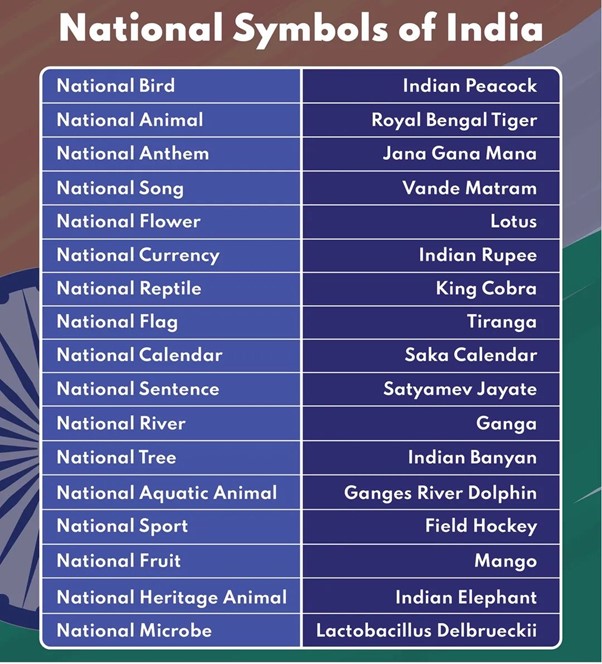
Importance of National Symbols of India
- There are 17 National Symbols of India, namely – Mango, Ganga, Royal Bengal Tiger, Indian Banyan, Tiranga, Jana Gana Mana, Saka Calendar, Vande Mataram, National Emblem of India, Ganges River Dolphin, Indian Peacock, Indian Rupee, King Cobra, Indian Elephant, Lotus, Pumpkin and National Pledge.
- First, they represent the country’s rich cultural heritage.
- They promote a great sense of pride in the hearts of the population of India.
- Be representative of anything particular to India and its people.
- Promote the chosen item to a broader audience.
- Help to safeguard the national symbol for future generations.
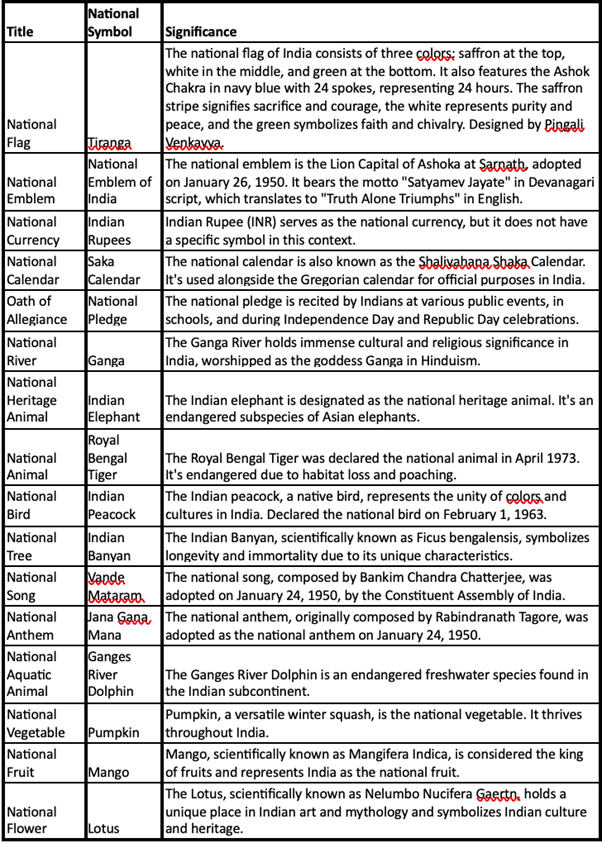
National Flag: Tiranga
- The Indian flag is called the Tiranga.
- The Constituent Assembly approved the flag on July 22, 1947.
- It was created by Pingali Venkayya.
- The saffron-colored flag is a symbol of the country’s power and bravery.
- Peace and honesty are represented by the Dharma Chakra’s white centre band.
- As a symbol of abundance and growth, green has long been associated with a place.
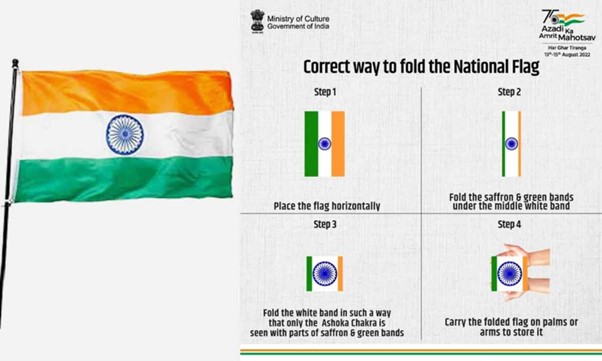
- Sarnath Lion Capital of Ashoka’s Sarnath abacus appears to have inspired its design.
- It is a distinctive wheel with almost the same diameter as the white band and 24 spokes.
- On July 22, 1947, India’s Constituent Assembly approved the country’s national flag design.
National Emblem
- The Indian National Emblem was accepted on 26 January 1950.
- It was designed by Madhav Sawhney.
- It is an adaptation from the Sarnath Lion Capital of Ashoka.
- There is a guiding principle here called Satyameva Jayate (“Truth Alone Triumphs).
- The words Satyameva Jayate (meaning ‘truth alone tirumphs’) from Mundaka Upanishad are inscribed below the abacus in Devanagari script.
- An abacus has four Asiatic lions standing back-to-back on it.
- It is located near Varanasi in Uttar Pradesh.
- Carved out of a single block of polished sandstone, the capital is crowned by the Wheel of the Law (Dharma Chakra).
- The four lions symbolizing power, courage and confidence, rest on a circular abacus.
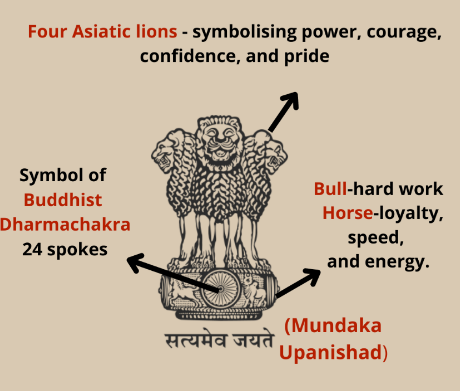
- The abacus is girdled by four smaller animals guardians of the four directions: the lion of the north, the elephant of the east, the horse of the south and the bull of the west.
- The abacus rests on a lotus in full bloom, exemplifying the fountainhead of life and creative inspiration.
- The use of the state emblem of India, as the official seal of the Government of India, is regulated by the State Emblem of India (Prohibition of Improper Use) Act, 2005.
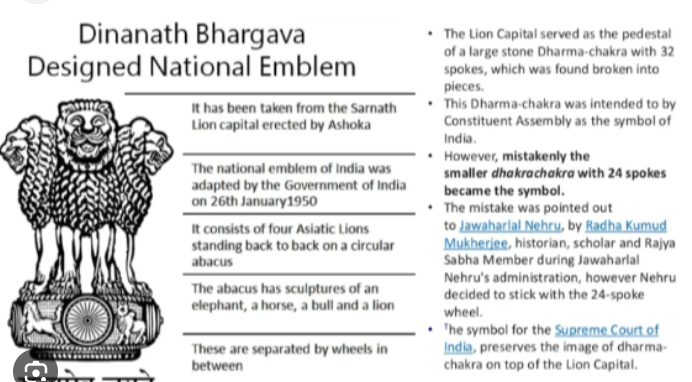
National Calendar: Saka Calendar
- The Indian national calendar is sometimes called the Shalivahana Shaka calendar.
- National Calendar was adopted on 22 March 1957, along with the Gregorian calendar.
- When the Calendar Committee first unveiled the Saka Calendar in 1957, it was widely regarded as a revolutionary timepiece.
- As per National Calendar, the months names are Chaitra, Vaishakh, Jyaishtha, Ashadha, Shravana, Bhadrapad, Ashwin, Kartik, Agrahayana, Pausha, Magha, and Phalguna.
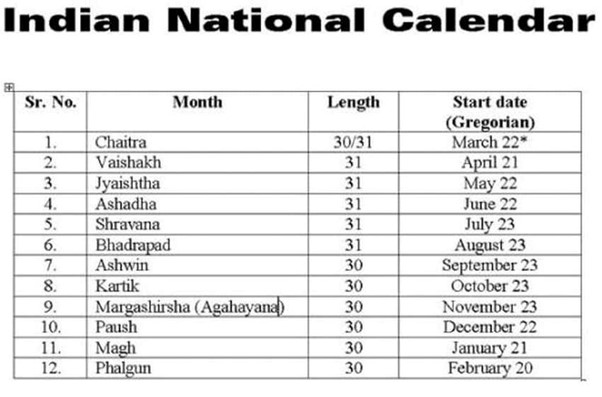
National Anthem: Jana Gana Mana
- A rendition of the Indian national anthem Rabindranath Tagore’s Bengali-language composition.
- Jana-Gana-Mana was declared the National Anthem of India on 24 January 1950 by the Constituent Assembly.
- It was initially performed on December 27, 1911, at the Indian National Congress’s Calcutta Session.
- A total of five stanzas makes up the Anthem.
- The “Indian National Anthem” is performed or sung on different occasions.
- The playing time of the National Anthem is approximately 52 seconds.
- A short version consisting of the first and last lines of the stanza (playing time approximately 20 seconds) is also played on certain occasions.
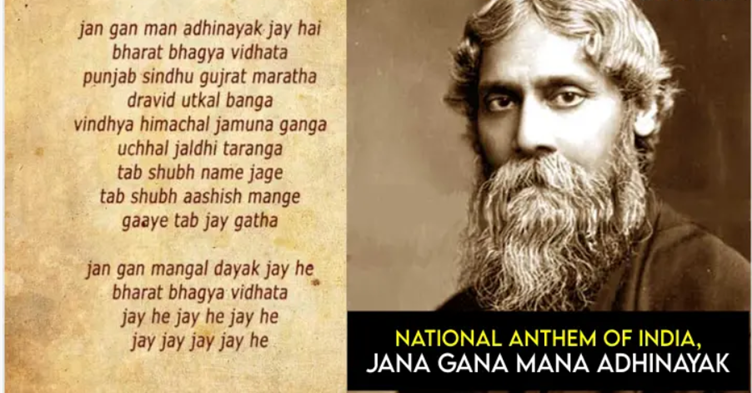
National Song: Vande Mataram
- The song Vande Mataram, composed in Sanskritised Bengali by Bankimchandra Chatterji.
- It was incorporated in his famous Bengali novel Ananda Math (1882).
- It has an equal status with the National Anthem.
- Later the song was set to tune by Rabindranath Tagore.
- It was sung for the first time at the annual session of the Indian National Congress held in 1896 at Calcutta.
- It was declared as the National Song in 1937 through a resolution.
- The English translation of the stanza was rendered by Sri Aurobindo.
- It was a source of inspiration to the people in their struggle for freedom.
- A speech by Dr Rajendra Prasad in the Constituent Assembly on 24 January 1950 stated that “the historical role played by Vande Mataram in the battle for Indian liberation, must be honored equally with Jana Gana Mana, it shall have equal standing with it.”
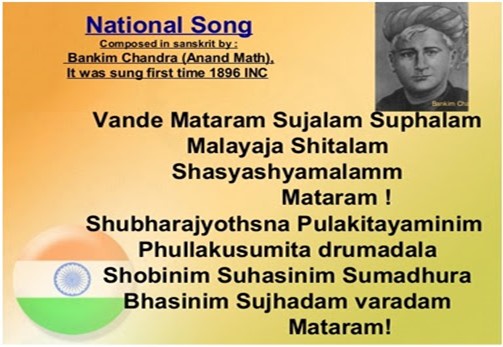
National Currency: Indian Rupee
- Currently, the Indian rupee (ISO code: INR) is used as the country’s official currency.
- The Reserve Bank of India issues currency in the country.
- As of 2010, the Latin letter “R” has been used as an Indian rupee symbol instead of the “र” (also pronounced as “ra”) consonant of the Devanagari alphabet.
- The symbol “₹” is an amalgamation of Devanagari “Ra” and the Roman Capital “R”.
- With two parallel horizontal stripes, they are running at the top representing the national flag and also the “equal to” sign.
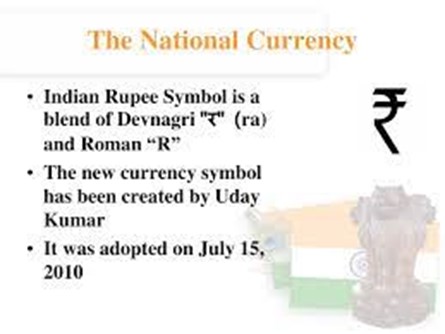
- Udaya Kumar Dharma lingam came up with the concept for it.
- The equality sign appears because of the country’s objective to eliminate economic inequality.
- The equality sign appears on the INR.
- INR’s design was chosen from a group of five symbols previously submitted for consideration.
- The pattern is based on Indian tricolor.
- The symbol was conceptualized and designed by Udaya Kumar, a post graduate in Design from Indian Institute of Technology Bombay.
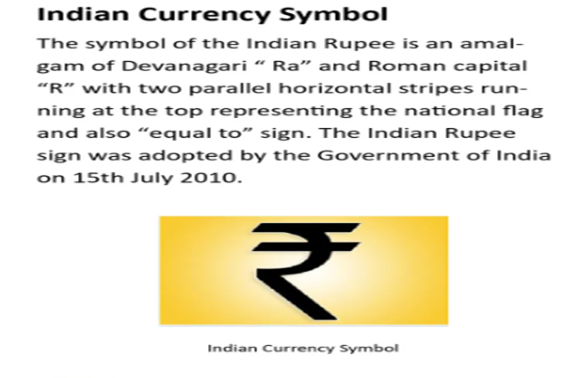
National River: Ganga River
- Ganga River or Ganges River was declared as the National River of India on November 4, 2008, by the Indian Prime Minister Manmohan Singh.
- Since then, it has been a part of the National Symbols of India.
- The Ganga or Ganges is the longest river of India flowing over 2,510 kms of mountains, valleys and plains.
- It originates in the snowfields of the Gangotri Glacier in the Himalayas as the Bhagirathi River.
- It is later joined by other rivers such as the Alaknanda, Yamuna, Son, Gumti, Kosi and Ghagra.
- The Ganga River basin is one of the most fertile and densely populated areas of the world and covers an area of 1,000,000 sq. kms.
- There are two dams on the river – one at Haridwar and the other at Farakka.
- The Ganga is revered by Hindus as the most sacred river on earth.
- Key religious ceremonies are held on the banks of the river at cities such as Varanasi, Haridwar and Allahabad.
- The Ganga widens out into the Ganges Delta in the Sunderbans swamp of Bangladesh, before it ends its journey by emptying into the Bay of Bengal.
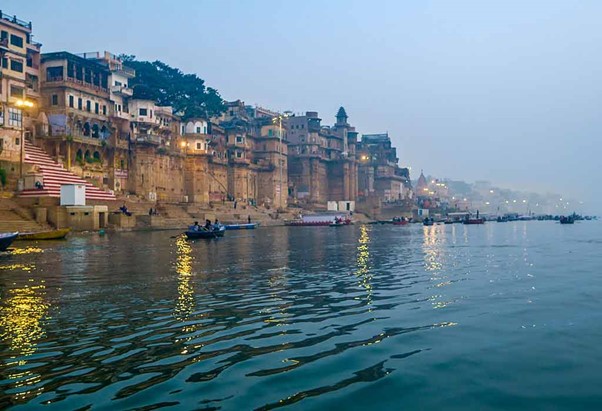
National Symbols of India
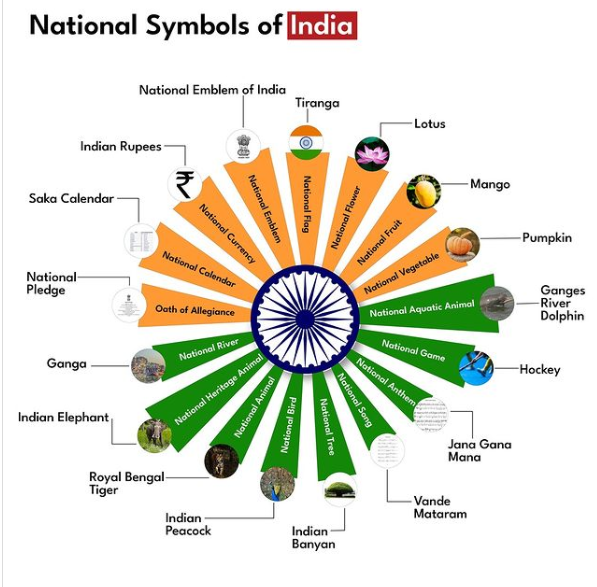
National Animal: The Bengal Tiger
- It is estimated that the Royal Bengal Tiger, India’s national animal, is among the world’s largest cats.
- Tiger is found in various parts of Asia, including India, Bangladesh, Nepal, Myanmar, and Sri Lanka.
- It is a rich-colored well-striped animal with a short coat.
- The combination of grace, strength, power has earned the tiger great respect and high esteem.
- Out of eight races of the species known, the Indian race is the Royal Bengal Tiger.
- The scientific name of the Royal Bengal Tiger is Panthera Tigris.
- The diminishing population of tigers led to the adoption of the tiger as India’s national animal in April 1973.
- Before the tiger, the Lion was India’s national animal in 1950.

National Bird: Peacock
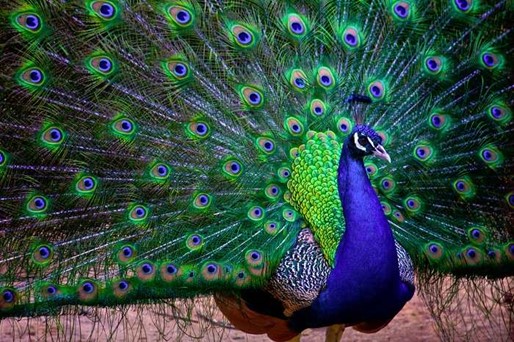
- The male of the species is more colorful than the female, with a glistening blue breast and neck and a spectacular bronze-green trail of around 200 elongated feathers.
- The female is brownish, slightly smaller than the male and lacks the trail.
- The elaborate courtship dance of the male, fanning out the tail and preening its feathers is a gorgeous sight.
- Peacocks are India’s national bird, and the Indian variety.
- Pavo cristatus is its most well-known representative.
- The peacock, a bird native to the subcontinent, symbolizes the unification of vibrant colours in Indian culture.
- It is a colourful, swan-sized bird with a fan-shaped crest.
- On February 1, 1963, the Peacock became the national bird of India.
- India’s lowland parts are home to this species, brewing there year-round.
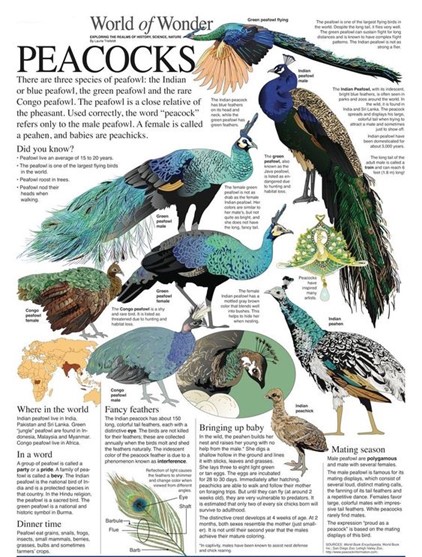
National Aquatic Animal: Dolphin
- In India, the Ganges River dolphin has been designated as the country’s National Aquatic Animal in 2010.
- Guwahati in Assam had become the first city in the country to have the Gangetic River Dolphin as its city animal.
- Also, Guwahati is home to a city-dwelling python.
- River dolphins are found in the Ganges, Yamuna, Chambal, and Brahmaputra rivers and their tributaries in South Asia.
- Gangetic Dolphin is said to represent the purity of the holy Ganga as it can only survive in pure and fresh water.
- It is listed by the IUCN as endangered on their Red List of Threatened Species.

National Fruit: Mango
- The national fruit of India is mango.
- It is affectionately referred to as “King of Fruits” (Mangifera indica).
- Many worldwide have fallen in love with its sweet aroma and delicious flavors since time immemorial.
- Prosperity and abundance are associated with the fruit because of its status as a national symbol.
- Mango is one of the most widely grown fruits of the tropical countries.
- In India, mango is cultivated almost in all parts, with the exception of hilly areas.
- Mangoes have been cultivated in India from time immemorial.
- The poet Kalidasa sang of its praises.
- Alexander savored its taste, as did the Chinese pilgrim Hieun Tsang.
- Akbar planted 100,000 mango trees in Darbhanga, known as Lakhi Bagh.
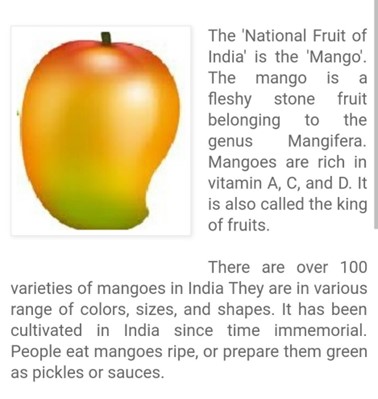
National Flower: Lotus
- Lotus or waterlily is an aquatic plant of Nymphaea with broad floating leaves and bright fragrant flowers that grow only in shallow waters.
- The aquatic herb known as ‘Padma’ in Sanskrit is revered in Indian culture as a magical talisman.
- It is a sacred flower that occupies a unique position in the art and mythology of ancient India.
- Spirituality, abundance, wisdom and purity of heart and mind are all associated with the lotus flower.
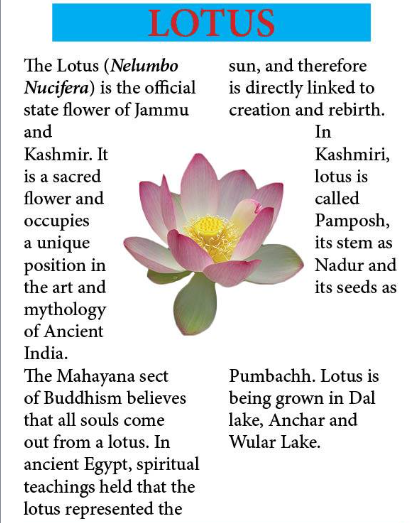
National Tree: Banyan
- Known as Ficus benghalensis, the Banyan tree is the official tree of India.
- Being linked to extended life and having numerous therapeutic benefits.
- This tree is frequently depicted as the fabled “Kalpa Vriksha” or the “Tree of Wish Fulfillment”.
- The branches of the Banyan Tree are rooted like new trees over a big region.
- Large numbers of animals can be found in the banyan tree because of its size and long-life cycle.

National River: Ganga
- They are known as the Ganges or the Ganga, India’s national river.
- It is known locally as the Bhagirathi River.
- It starts in the Himalayas on the Gangotri Glacier’s snow-covered snowfields.
- Hindus consider the Ganges River to be the most holy river on the Earth.
- There are 2,510 kilometers of mountain, plain, and valleys in the Ganga River basin.
- It is making the longest river in India.
- It flows through the main Indian cities of Varanasi, Allahabad, and Haridwar.

National Reptile: King Cobra
- An Ophiophagus hannah is the Indian King Cobra or Snake Eater.
- It serves as the country’s official reptile.
- It can be found in Indian and Southeast Asian forests.
- It is the world’s longest venomous snake.
- It can grow to a maximum length of 19 feet and live for as long as 25 years.
- They can inject up to 6 ccs of venom into each bite.
- In Hinduism, the king cobra is also known as a Naga, and they are revered and adored as gods.
- Shiva is generally represented as the god of death with a cobra wrapped around his neck.

National Heritage Animal: Indian Elephant
- The Indian elephant is the national heritage animal of India since 22 October 2010.
- The Indian elephant (Elephas maximus indicus) has been declared as the national heritage animal by the government in order to conserve its dwindling population.
- 60% of the Asian elephants live in India.
- There are over 25,000 elephants in the country, including 3,500 in captivity in zoos and temples –
- They are particularly in southern and north-eastern parts of the country.
- Indian Elephant has been listed as endangered by IUCN as the population has declined by at least 50% over the last three generations.
- It has been declared an endangered species because of habitat loss, fragmentation, and degradation.
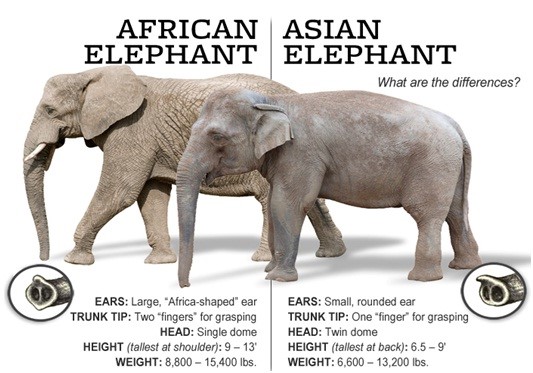
Oath of Allegiance: National Pledge
- Indians are required to take the National Pledge, in which they swear allegiance to the country.
- People in India often recite it in unison, notably at school functions and on national holidays like Independence Day and Republic Day.
- In 1962, Pydimarri Venkata Subba Rao, a Telugu writer, penned the promise.
- Consequently, it has been translated into several different languages, beginning with Visakhapatnam in 1963.
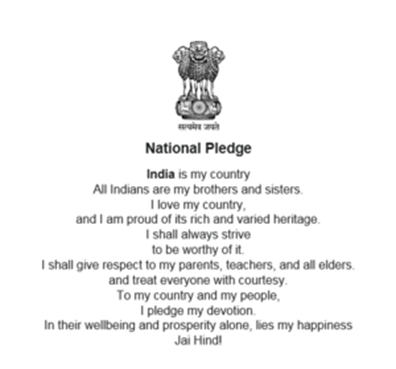
National Game
- The Ministry of Youth Affairs and Sports of India clarified that, officially, the country does not have a national game; no game, including hockey, has been notified as such.
National Vegetable Pumpkin
- The national vegetable of India is the pumpkin.
- Pumpkin is a winter squash that is round with smooth and ribbed skin which is yellow.
- It grows throughout India and doesn’t have many soil requirements to grow.
- Pumpkin can be grown easily as a climber or creeper.

National Microbe
- Lactobacillus is declared the National Microbe for India in October 2013.
- It is used for the production of yogurt.
